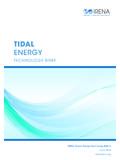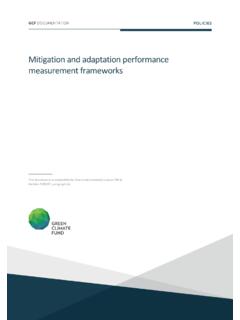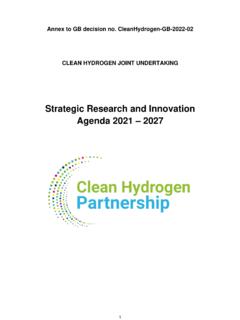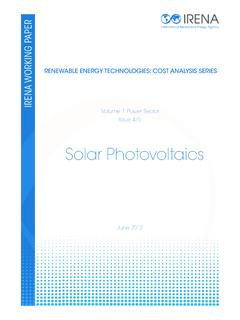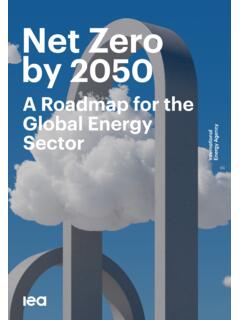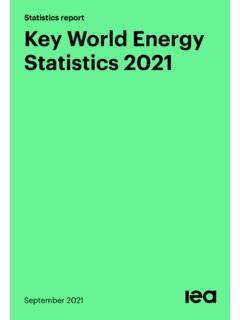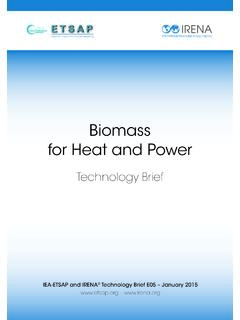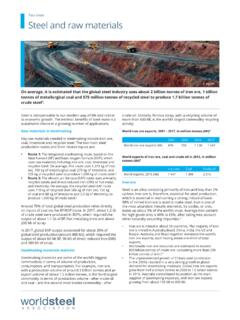Transcription of ENERGY PROFILE Nigeria - IRENA
1 ENERGY PROFILER enewable ENERGY (% of TFEC) to electricity (% of population) efficiency (MJ per $1 of GDP) to clean cooking (% of population)11 Public flows renewables (2018 USD M) capita renewable capacity (W/person) (TJ)1 413 2451 637 987 Renewable (TJ)4 569 6074 954 442 Total (TJ)5 982 8526 592 429 Renewable share (%)7675 Growth in TPES2013-182017-18 Non-renewable (%)+ (%)+ + (%)+ + ENERGY trade20132018 Imports (TJ) 735 444 854 081 Exports (TJ)5 129 5074 894 036 Net trade (TJ)4 394 0634 039 955 Imports (% of supply)1213 Exports (% of production)4946 ENERGY self-sufficiency (%)174161 Net trade (USD million)+ 70 357+ 45 947 Net trade (% of GDP)+ + by source20132018 Electricity (TJ) 18 266 25 214 Heat (TJ) 0 0 Bioenergy (TJ)4 196 6884 526 138 Solar + geothermal (TJ) 0 0 Total (TJ)4 214 9544 551 352 Electricity share (%)01 Consumption growth2013-182017-18 Renewable electricity (%)+ + renewables (%)+ + (%)+ + by sector20132018 Industry (TJ) 296 295 179 813 Transport (TJ) 0 0 Households (TJ)3 814 8144 248 356 Other (TJ) 103 844 123 184 Renewable share of PRIMARY ENERGY SUPPLY (TPES)
2 Total primary ENERGY supply in 2018 RENEWABLE ENERGY CONSUMPTIONR enewable ENERGY supply in 2018 Renewable ENERGY consumption in 2018 SUSTAINABLE DEVELOPMENT GOAL 7: ENERGY INDICATORS (2018)15%10%0%75%OilGasNuclearCoal + othersRenewables1%0%99%Hydro/marineWindS olarBioenergyGeothermal1%99%ElectricityH eatBioenergySolar +geothermal4%93%3%IndustryTransportHouse holdsOtherCapacity in 2020MW%Non-renewable 11 002 84 Renewable 2 153 16 Hydro/marine 2 111 16 Solar 28 0 Wind 3 0 Bioenergy 10 0 Geothermal 0 0 Total 13 154 100 Capacity change (%)2015-202019-20 Non-renewable+ 30+ + 1+ Solar+ 67+ Bioenergy+ + 24+ in 2019 GWh%Non-renewable 25 05975 Renewable 8 49225 Hydro and marine 8 43025 Solar 410 Wind 00 Bioenergy 210 Geothermal 00 Total 33 552100 Solar+ 0 Bioenergy 0 Wind+ 3 0 Renewable capacity in 2020 Non-renewable 0 Net capacity change (MW)Net capacity change in 2020 (MW)Per capita electricity generation (kWh)GeothermalCapacity utilisation in 2019 (%)Renewable generation (GWh)
3 ELECTRICITY CAPACITY AND GENERATION+ 65 Hydro and marine 0 5001 0001 5002 0002 500201520162017201820192020 Non-renewableRenewable231746260204060801 00 GeoBioWindSolarHydro/MarNuclearFossil 0 2 000 4 000 6 000 8 000 10 000201420152016201720182019 Hydro/marineSolarWindBioGeo 0 50 100 150 200201420152016201720182019 TotalRenewable98%1%0%0%Hydro/marineSolar WindBioenergyGeothermal374 Most immediate clean ENERGY targets & NDCsyeartargetRenewable ENERGY :Renewable electricity:2020 38%Renewable capacity:Renewable transport:Liquid Biofuel blending mandate:Other transport targets:Renewable heating/cooling:Renewable HydropowerOff-grid renewable technologies: ENERGY efficiency ( ENERGY ): ENERGY efficiency (Electricity):Latest policies, programmes and legislation1202122020320194201952018 References to sustainable ENERGY in Nationally Determined Contribution (NDC)ConditionalUnconditionalunit- Renewable ENERGY - electricity - transport - heating/cooling- ENERGY efficiency2019 Avoided emissions based on fossil fuel mix used for powerCalculated by dividing power sector emissions by elec.
4 + heat Economic Sustainability PlanFramework for the implementation of intervention facility for the national gas expansion programmeFDNIS ECOSTAND 071-2:2017EE: Minimum ENERGY Performance Standards Part 2: Air conditioning productsNigeria's National Action Plan to reduce short-lived climate pollutantsFlare Gas (Prevention of Waste and Pollution) Regulations 2018CO2 emission factor for elec. & heat generation Avoided emissions from renewable elec. & heatENERGY AND EMISSIONSE nergy-related CO2 emissions by sectorElec. & heat generation CO2 emissions inTARGETS, POLICIES AND 50 100 150201420152016201720182019Mt CO2 EmissionsElec.
5 & heatOther IndustrialTransportOtherBuildings0%100%0 %Coal + othersGasOil 14Mt 5 10 15 20 25201420152016201720182019Mt CO2 EmissionsEmitted CO2RE Avoided CO2+14% 200 400 600 800201420152016201720182019tCO2 /GWhNGAA fricaWorld WorldNigeriaNigeriaWorldDistribution of solar potentialDistribution of wind potentialBiomass potential: net primary productionIRENA HeadquartersMasdar Box 236, Abu DhabiUnited Arab of renewable resource potentialSources: IRENA statistics, plus data from the following sources: UN SDG Database (original sources: WHO; World Bank; IEA; IRENA ; and UNSD); UN World Population Prospects; UNSD ENERGY Balances; UN COMTRADE; World Bank World Development Indicators; EDGAR; REN21 Global Status Report; IEA- IRENA Joint Policies and Measures Database; IRENA Global Atlas; and World Bank Global Solar Atlas and Global Wind Atlas.
6 Additional notes: Capacity per capita and public investments SDGs only apply to developing areas. ENERGY self-sufficiency has been defined as total primary ENERGY production divided by total primary ENERGY supply. ENERGY trade includes all commodities in Chapter 27 of the Harmonised System (HS). Capacity utilisation is calculated as annual generation divided by year-end capacity x 8,760h/year. Avoided emissions from renewable power is calculated as renewable generation divided by fossil fuel generation multiplied by reported emissions from the power sector.
7 This assumes that, if renewable power did not exist, fossil fuels would be used in its place to generate the same amount of power and using the same mix of fossil fuels. In countries and years where no fossil fuel generation occurs, an average fossil fuel emission factor has been used to calculate the avoided profiles have been produced to provide an overview of developments in renewable ENERGY in different countries and areas. The IRENA statistics team would welcome comments and feedback on its structure and content, which can be sent to Last updated on.
8 29th September, 2021 RENEWABLE RESOURCE POTENTIAL0%20%40%60%80%100%Proportion of land area<260 260-420 420-560 560-670 670-820 820-1060 >1060 Wind power density at 100m height (W/m2)012345678910110%20%40%60%80%100%Pr oportion of land area<1200 1200-1400 1400-1600 1600-1800 1800-1900 1900-2000 >2000 Annual generation per unit of installed PV capacity (kWh/kWp/yr) : Solar resource potential has been divided into seven classes, each representing a range of annual PV output per unit of capacity (kWh/kWp/yr). The bar chart shows the proportion of a country's land area in each of these classes and the global distribution of land area across the classes (for comparison).
9 Onshore wind: Potential wind power density (W/m2) is shown in the seven classes used by NREL, measured at a height of 100m. The bar chart shows the distribution of the country's land area in each of these classes compared to the global distribution of wind resources. Areas in the third class or above are considered to be a good wind : Net primary production (NPP) is the amount of carbon fixed by plants and accumulated as biomass each year. It is a basic measure of biomass productivity. The chart shows the average NPP in the country (tC/ha/yr), compared to the global average NPP of 3-4 tonnes of carbon per Global averageof 3-4 tC/ha/yr


